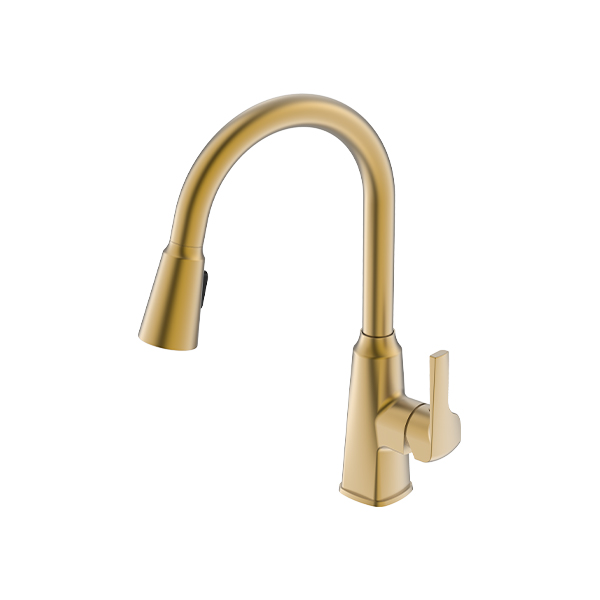A single-lever kitchen mixer tap is an essential fixture in modern kitchens, offering convenience and functionality with a sleek, minimalist design. This type of faucet allows users to control both the water temperature and flow rate using a single lever, making it a popular choice for contemporary kitchen setups. Its user-friendly design and versatility are good for various kitchen tasks, from washing dishes to food preparation.

Key Features of Single-Lever Kitchen Mixers
1. Easy Temperature and Flow Control
The primary feature of a single-lever kitchen mixer is its ability to control both the temperature and water flow with a single handle. This lever is typically designed to move horizontally or vertically, depending on the model. By adjusting the position of the lever, users can easily regulate the temperature, shifting from hot to cold, and adjust the water flow to suit different tasks.
This intuitive design reduces the complexity of older dual-handle faucets, which require separate adjustments for hot and cold water. The single lever provides smoother operation, making it easier and quicker to find the desired water temperature and flow rate, especially when hands are occupied with dishes or cooking.
2. Space-Saving Design
Another significant feature of single-lever kitchen mixers is their space-saving design. The compact nature of the faucet eliminates the need for two separate handles, freeing up counter space and contributing to a cleaner, more streamlined aesthetic in the kitchen. This makes the single-lever mixer ideal for smaller kitchens where space is essential.
Additionally, the sleek design of the faucet complements modern kitchen interiors. The faucet’s simplicity allows it to blend seamlessly with a variety of sink styles and countertop materials, making it a versatile choice for both contemporary and traditional kitchens.
3. Smooth and Efficient Operation
Single-lever kitchen mixers are designed to provide smooth operation with minimal effort. The handle is engineered to operate effortlessly, whether you are turning the water on or adjusting the flow rate. Many high-quality models use ceramic disc cartridges, which ensure smooth movement of the lever and provide long-lasting durability.
These ceramic cartridges help eliminate issues such as drips and leaks, which can often occur in traditional faucets with rubber washers. With a single-lever mixer, users can expect consistent, drip-free operation over time, reducing the need for frequent repairs or maintenance.
4. Durability and Quality Construction
Single-lever kitchen mixers are typically made from high-quality materials, such as stainless steel, brass, or chrome-plated metal. These materials are chosen for their resistance to corrosion, rust, and staining, ensuring the longevity of the faucet even in high-moisture environments like kitchens.
Additionally, many single-lever mixers come with finishes that resist water spots and fingerprints, keeping the faucet looking clean and polished with minimal upkeep. These finishes also add a layer of protection, helping the faucet withstand the wear and tear of daily use.
5. Ergonomic Design
The ergonomic design of single-lever mixers makes them comfortable and easy to use. The lever is usually designed to fit naturally in the hand, allowing users to adjust water temperature and flow with minimal effort. For those with limited mobility, single-lever faucets can be a more accessible option, as they require less dexterity compared to traditional faucets with separate handles.
Some models even offer extended levers or touchless functionality for enhanced convenience. The ergonomic design not only improves usability but also adds a touch of sophistication to the kitchen.
6. Versatility and Compatibility
Single-lever kitchen mixers come in a wide range of styles and sizes, allowing them to be used in different types of kitchens and with various sink configurations. Whether you're outfitting a large farmhouse sink or a small apartment kitchen, there are single-lever mixers that suit your specific needs.
Some models are designed with additional features, such as pull-out or pull-down spouts, which provide greater flexibility when rinsing dishes, vegetables, or cleaning the sink. These faucets offer the convenience of extra reach and can be easily maneuvered for more complex tasks, further enhancing their versatility.
Precautions When Using Single-Lever Kitchen Mixers
1. Proper Installation
To ensure the longevity and proper functioning of a single-lever kitchen mixer, it is important to have it installed correctly. Incorrect installation can leaks, poor water flow, or even damage to the faucet. It is advisable to hire a professional plumber or follow the manufacturer’s guidelines if you choose to install the faucet yourself.
Additionally, the faucet should be installed in the right position in relation to the sink, ensuring that the water flows directly into the basin without splashing onto the countertop or backsplash. Proper alignment of the faucet will also prevent undue stress on the lever mechanism.
2. Regular Cleaning and Maintenance
To keep your single-lever kitchen mixer in condition, regular cleaning and maintenance are essential. Hard water deposits, soap scum, and other debris can accumulate over time, affecting the performance and appearance of the faucet.
It’s important to clean the faucet regularly using a mild, non-abrasive cleaner and a soft cloth. Avoid harsh chemicals or abrasive scrubbing pads, as they can damage the finish or cause scratches. If the faucet has a pull-out or pull-down spout, be sure to clean it thoroughly to prevent blockages in the nozzle.
For models with aerators, periodically remove and clean the aerator to ensure smooth water flow. Over time, the aerator can become clogged with mineral deposits, reduced water pressure or inconsistent flow.

 English
English Español
Español

